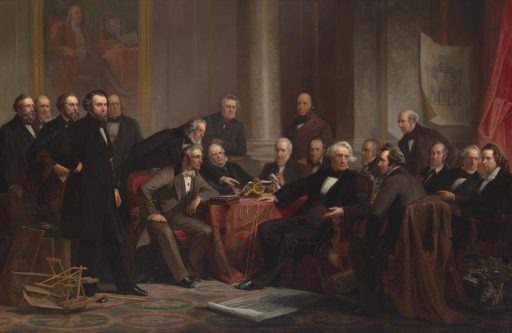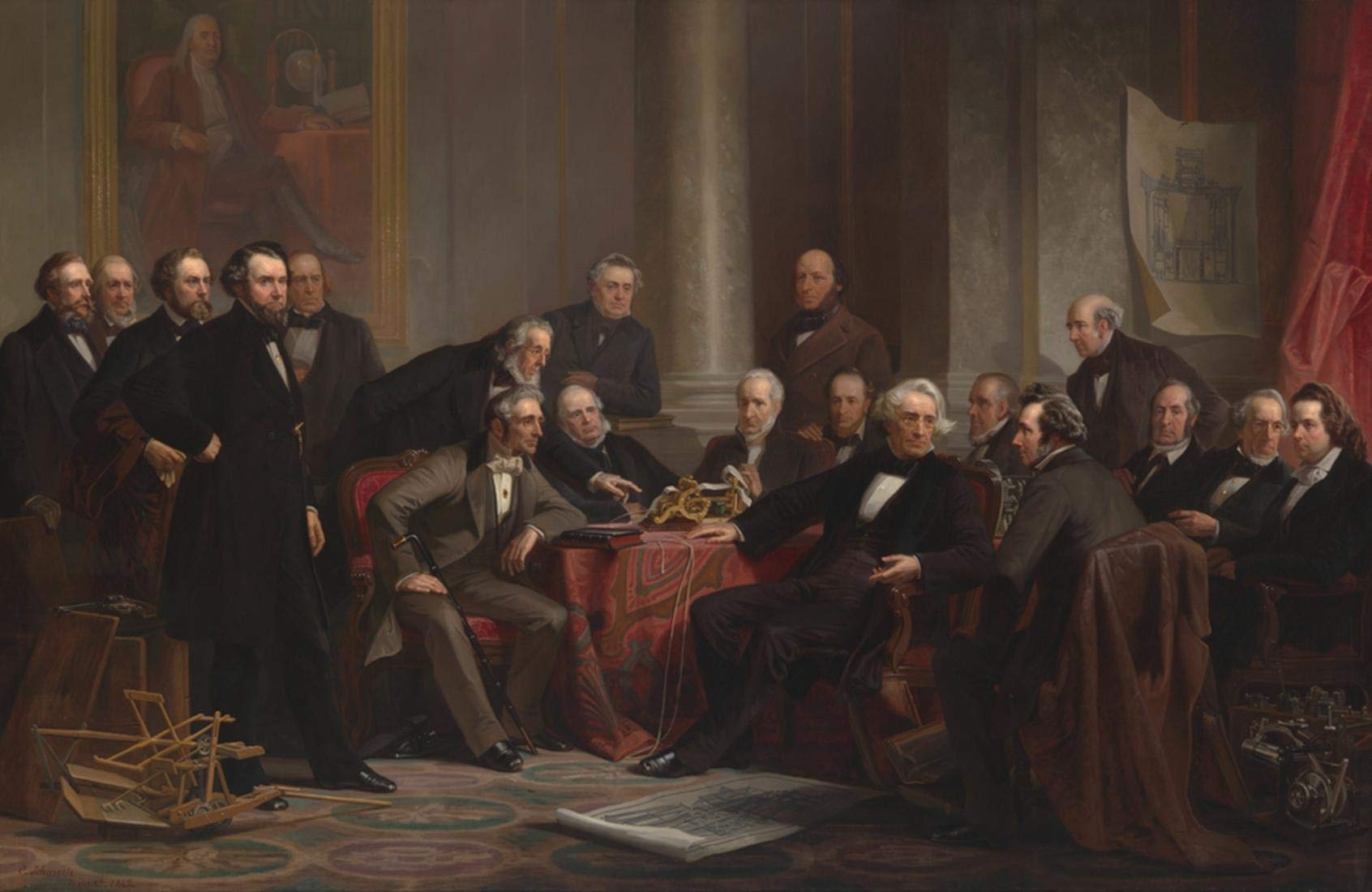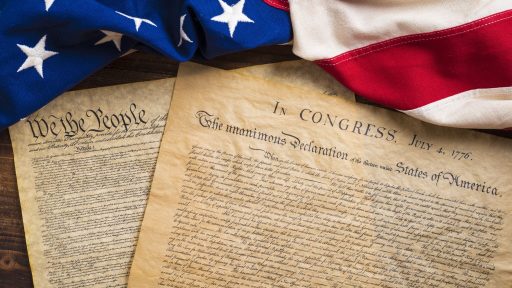Interpose – to be or come between, to mediate; intervene
Webster’s New Collegiate Dictionary“Let every soul be subject to the governing authorities. For there is no authority except from God, and the authorities that exist are appointed by God.”
Romans 13:1 NKJV“Only if constitutional officers have the resolve to resist the Supreme Court will the foundation of constitutional rule be restored in the United States.”
Alabama Governor Fob James“You think the people of this country exist to provide you with position; I think your position exists to provide these people with freedom.”
Mel Gibson portraying Scottish freedom fighter William Wallace in the movie Braveheart
Introduction
The doctrine of interposition, rooted in the Bible and Christian concepts of government, is the foundation of legitimate resistance to governmental tyranny. The doctrine has been developed and refined by Christian thinkers over the last five hundred years. Interposition was used in obtaining the Magna Charta and justifying the American Revolution. Often, interposition was used to bring a potential tyrant under control without the use of force.
The God revealed in the Bible is a God of order and authority. In practice, the doctrine of interposition recognizes legitimate authority and resists the chaos of anarchy. When a government abuses the rights or liberties of the people who instituted it, a remedy is provided by the interposition of lessor magistrates. This interposition is not only legitimate, it is a responsibility given by God.
History and Development
Author Gary Amos describes interposition as “resistance to tyranny through lower magistrates.” Amos develops this “Christian theory of revolution” as follows: “If through acts of tyranny the highest ruler in a country forfeits his right to rule, lower officers who still have a right to rule can declare a change in government. 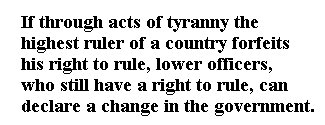 Those who have a right to rule must be representing the law and ‘the people,’ because the people can resist tyrants only through lawful representatives.” [1]
Those who have a right to rule must be representing the law and ‘the people,’ because the people can resist tyrants only through lawful representatives.” [1]
According to Amos, the “Christian theory of interposition” has its roots in the Gregorian Reform in the Eleventh and Twelfth Centuries. Manegold of Lautenbach “was a Catholic scholar picked by Pope Gregory VII to explain why Emperor Henry IV could lawfully be deposed.” Because Henry VI “had broken his contract [2] with the people and was in material breach. . . through tyrannically destroying peace and justice,” Manegold explained, “the people, represented by all the princes collectively, were absolved from allegiance to him and free to depose him.” [3]
Amos maintains that “if it was the papalists who produced the theory of interposition, it was the Protestants who perfected it.” He traces the theory through Martin Luther and John Calvin; the Huguenots and Vindiciae Contra Tyrannos; Samuel Rutherford’s Lex Rex; John Locke’s Second Treatise of Government; and finally to the American Founders. [4]
John Calvin, in his monumental work Institutes of the Christian Religion, developed a theory of government that included the concept of interposition. “With regard to the function of magistrates. . . . It is thereby intimated that they have a commission from God, that they are invested with divine authority, and in fact, represent the person of God, as whose substitutes they in a manner act.” [5] Here Calvin establishes that magistrates are to rule representing God’s authority. He adds the element of accountability by asserting “that they [the magistrates] may be animated to duty when they hear that they are ambassadors of God, to whom they must one day render an account of the province committed to them. . . . for if they sin in any respect . . .they also insult God himself, whose sacred tribunals they pollute.” [6]
Calvin then states that “private men” are not given the right of vengeance against unjust rulers, but that “when popular magistrates have been appointed to curb the tyranny of kings [and do not do so] . . . their dissimulation is not free from nefarious perfidy, because they fraudulently betray the liberty of the people, while knowing that, by the ordinance of God, they are its appointed guardians.” [7] In other words, according to Calvin, God vests the responsibility in lower magistrates to protect the rights and liberties of the people. This duty includes the prospect of resisting the highest rulers in the land, should they abuse the people’s liberties.
Vindiciae Contra Tyrannos (“Defense of Liberty Against Tyrants”) was “the most famous and most quoted of the many Protestant tracts on interposition. . . . [and] it was the authority upon which most of the later Puritan revolutionary thought was based.” [8] Vindiciae states that “the law of nature teaches and commands us to maintain and defend our lives and liberties,” and the people “who publicly renounce the unjust dominion of a tyrant” are free from “perfidiousness” (duplicity). [9] In other words, even though the people have a duty to submit to “the governing authorities” (Romans 13), a ruler who acts tyrannically forfeits his legitimate authority and the people are free to resist. “It is therefore permitted the officers of a kingdom, either all, or some good number of them, to suppress a tyrant; and it is not only lawful for them to do it, but their duty expressly requires it.” [10]
Biblical Examples
The Bible inspired the development of the theory of interposition, of which it contains many examples. Jesus Christ, the Son of God, interposed Himself between the judgment 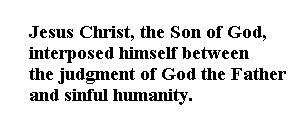 of God the Father and sinful humanity. Of course, this example is not a pure analogy of political interposition because God would not have been “tyrannical” even if He did destroy humanity—we fully deserve His judgment. However, Jesus is an example of a (voluntarily) “lessor” [11] authority placing himself between His people and the Authority above Him.
of God the Father and sinful humanity. Of course, this example is not a pure analogy of political interposition because God would not have been “tyrannical” even if He did destroy humanity—we fully deserve His judgment. However, Jesus is an example of a (voluntarily) “lessor” [11] authority placing himself between His people and the Authority above Him.
When Athaliah wrongly made herself Queen of Israel and acted as a tyrant, Jehoiada the priest “made covenants with the leaders of Israel to remove Athaliah from the throne.” In this example, Jehoiada and the leaders of Israel interposed themselves between the Queen and the people, and brought an end to her unlawful reign. [12]
Numerous Old Testament prophets interposed by calling wicked kings to account for their evil deeds. The prophetic office had an interpositional nature—part of the prophet’s “job” was to confront those in governmental authority. After King David sinned with Bathsheba and murdered her husband, Nathan—acting in the office of the prophet—confronted David. Even though Nathan had enjoyed David’s favor in the past, he was still risking his office (and possibly his life) by pointing out the sins of his king in such a direct manner. [13]
Following King Ahab and Jezebel’s murder of Naboth, and subsequent theft of his vineyard, God sent the prophet Elijah to confront Ahab. This example is significant in at least two ways. First, it implies that interposition is a duty, i.e., God commanded Elijah to confront Ahab; and second, Elijah’s position of authority (office of the prophet), gave him the credibility and legitimacy needed to challenge Ahab. [14]
The Magna Charta
The celebrated document that marked the end of divine right of kings and the establishment of Lex Rex (the rule of law, not men) was obtained through interposition. The Magna Charta (Great Charter) was the result of King John’s arbitrary and tyrannical rule over England in the early 1200s. King John’s abuses included imposing heavy taxes, restricting of trading privileges for merchants, confiscation of church property, and attempts to influence church elections. He also hired “unscrupulous foreign adventurers as royal officers and as sheriffs and bailiffs in every county of the land.” [15]
At the time of King John, the barons played the role of lessor magistrates in England. The barons found their rights and privileges infringed, so they resolved to fight this usurpation. After producing a copy of Henry I’s Charter of Liberties (the forerunner of the Magna Charta) as legal recognition of their rights, they pledged their lives to fight for the liberties listed in the Charter. The showdown came at Runnymede on June 15, 1215, where John capitulated to the armed barons and agreed to the provisions of the Magna Charta. [16]
Although it went through several changes and re-issues, the Magna Charta is considered the genesis of American, as well as English, liberties. Its provisions included: “limiting the power of government and securing to the individual the rights of trial by jury, the protection of the writ of habeas corpus, and the guarantee that no person could be deprived of life, liberty, or property without due process of law.” [17]
King John’s submission to the Magna Charta was half-hearted, however, and he quickly enlisted the support of Pope Innocent III against the barons. Innocent III, a tyrant in church robes, declared the Magna Charta void and reminded the barons that he “was lord of all England and that nothing could be done without his consent.” He excommunicated “those who had persecuted” the King. [18]
This complication did not deter the barons who were determined to protect their valuable liberties in the face of this new challenge. The deaths of both Pope Innocent III and King John less than two years after the signing of the Magna Charta ensured its viability and gave the barons the victory they desired.
The American Revolution
The American colonists acted in full harmony with the doctrine of interposition in their resistance to King George III and the English Parliament. From The Resolutions of the Stamp Act Congress to the Declaration of Independence, the colonists presented their grievances through their legitimate representatives. Their protests were tempered and gradual in escalation. The colonists went out of their way to make reasonable appeals for the restoration of their “rights as Englishmen.” Force was only reluctantly utilized, and then only as a last resort.
The Stamp Act Congress (1765) was motivated by the Massachusetts House of Representatives, which sent a circular letter to each of the colonies suggesting that each appoint a committee to “consult together. . .and to consider of a general and united, dutiful, loyal, and humble representation of their condition to his majesty and to parliament, and to implore relief.” Nine of the colonies sent representatives to New York for the purpose of “dutiful” protest of the Stamp Act. The document they produced attested to their “warmest sentiments of affection and duty to his majesty’s person and government,” but also called the effects of the Stamp Act subversive to “the rights and liberties of the colonists.” [19] In this case, their interposition was respectful, and direct in its claim to legitimate rights.
The next step in the slow escalation towards independence was the 1774 meeting of the First Continental Congress. The Congress of representatives (lessor magistrates) from every colony except Georgia met “to consider measures to be taken for the recovery and establishment of their just rights and liberties and for the restoration of union and harmony between Great Britain and the colonies.” The Resolves of the First Continental Congress listed rights and the infringements of those rights perpetrated by Great Britain. The Resolves stated that the colonies, “justly alarmed at these arbitrary proceedings of parliament and administration, have severally elected, constituted, and appointed deputies . . . in order to obtain such establishment, as that their religion, laws, and liberties, may not be subverted.” [20]
The following year, with the situation worsening and blood having been shed at Lexington Green, the Second Continental Congress met to interpose and issue yet another document listing their grievances and intentions. The Second Congress issued the Declaration of the Causes and Necessity of Taking Up Arms with the hope that reconciliation was still possible. This document traced the history of the American colonies with respect to their relationship with England, and like those before it, made plain the complaints and intentions of the colonies. [21]
The interposition of the colonial representatives reached the point of no return with the Declaration of Independence in July of 1776. Immediately prior to the Declaration, the Continental Congress “urged all the colonies to form separate governments for the exercise of all authority.” [22] Namely, the tyranny of England had reached the point where its exercise of authority was illegitimate and the colonies had the right to form new governments.
 Throughout the colonies’ struggle to reclaim their rights, the lessor magistrates representing them made appeals to God to protect them and to judge the righteousness of their intentions. If one were to judge from the outcome, it is obvious that God did bless their endeavors to interpose themselves between the tyranny of England and the colonists.
Throughout the colonies’ struggle to reclaim their rights, the lessor magistrates representing them made appeals to God to protect them and to judge the righteousness of their intentions. If one were to judge from the outcome, it is obvious that God did bless their endeavors to interpose themselves between the tyranny of England and the colonists.
Interposition by State Governments
In 1798, the United States Congress, less than eight years after the adoption of the Bill of Rights, passed a series of laws know as the Alien and Sedition Acts. These acts were ostensibly directed at foreigners, particularly English and French citizens, who the Congress worried would be “the irresponsible agents of a reckless and almost revolutionary agitation, which might jeopardize the very existence of the young government, but ten years established, over which they had been bidden to preside.” [23] The Alien and Sedition Acts “authorized the arrest and deportation of turbulent and dangerous aliens at the discretion of the President, even in time of peace, and the arrest, trial, and punishment of any one who should either unlawfully combine with others to oppose any measure of government or “write, print, utter, or publish” anything with intent to defame the President or the houses of Congress, or to weaken their authority and bring them into contempt.” [24] In other words, if Congress had its way, the First Amendment was (in the immortal words of Monty Python) “right out.”
A storm of protest erupted immediately from all parts of the fledgling country. Many petitions demanding repeal and containing thousands of signatures were sent to the Federal government. Yet individual protests were not enough. Thus, the peoples elected representatives, in their capacity of lessor magistrates serving in the state governments of Virginia and Kentucky, responded by passing resolutions “drawn in solemn form and sent through their governors to the legislatures of all the other States . . . called the attention of the entire country to definitions of constitutional right as between the people and the federal government.” [25]
The Virginia Resolution (1798), written by James Madison, stated that the members of the Virginia assembly considered it “their duty to watch over and oppose every infraction of those principles which constitute the only basis of [the] union. . . . The states have the right, and are duty bound, to interpose for arresting the progress of the evil, and for maintaining within their respective limits, the authorities, rights and liberties appertaining to them.” [26]
The most raucous response came from the State of Kentucky, which passed its resolution in 1799. The Kentucky Resolution (authored by Thomas Jefferson) remarked that the Kentucky representatives “would be faithless indeed to themselves, and to those they represent, were they silently to acquiesce in principles and doctrines…” The Kentucky Resolution called the Alien and Sedition Acts “palpable violations” of the Constitution and the “silent acquiescence” of the other state governments “highly criminal.” [27]
The influence of John Calvin is evident in both resolutions, but the Virginia Resolution’s language could have been drawn directly from the Institutes. Clearly, both state legislatures viewed it as their duty to interpose themselves between the Federal government and the rights and liberties of their citizens; and to protect the principles of the Constitution.
Modern Day Interposition
We are not without modern day patriot heroes who are willing to place themselves between encroaching tyranny and the American people. Alabama Governor Fob James Jr., “a serious student of the Constitution and well-versed in the writings of the Founding Fathers,” [28] has taken his oath to uphold the United States Constitution seriously. Fob James took the oath of office in 1995, with “a large banner emblazoned with the words of the Tenth Amendment: ‘The powers not delegated to the United States by the Constitution, nor prohibited by it to the States, are reserved to the States respectively, or to the people’” waving behind him. [29] This gesture served notice of his intention to value the original intent of the Founders.
Several times since his inauguration, Governor James has used his position to resist Federal government aberrations. One of the first things James did was to pull Alabama out of the Federal education program, Goals 2000, early in his term. [30] Goals 2000 is a program whereby States can apply for and receive federal money for use in their states. An examination of the Constitution, specifically the enumerated powers in Article II, Section 8, reveals no grant of authority whatsoever to the Federal government regarding education. Typically, when the Federal government provides money to the states under the auspices of various programs, there are “strings attached,” or conditions that the States must meet before they receive the money. By pulling Alabama out of Goals 2000, Governor James would have avoided the strings that came with Goals 2000 education money.
In 1996, a lawsuit seeking the removal of the Ten Commandments from Alabama Judge Roy Moore’s courtroom brought Governor James’ intervention. James declared that he would call out the Alabama National Guard if that was necessary in order to keep the Ten Commandments on Judge Moore’s wall. With this action, Governor James made the case a “separation of powers issue, involving questions of state versus federal jurisdiction and judicial versus legislative versus executive power.” [31]
In 1997, the American Civil Liberties Union (ACLU) filed a lawsuit against a 1977 Alabama law permitting “non-sectarian, non proselytizing, student-initiated voluntary prayer” in the public schools. The lawsuit succeeded in getting United States District Judge Ira DeMent to rule the Alabama statute unconstitutional. The ACLU’s status as perennial guardians of their version of “a wall of separation between church and state” notwithstanding, Governor James wrote a well-documented 34-page letter to Judge DeMent explaining why the case was a state rather than federal issue. [32]
Calling the Alabama law “anemic and beggarly,” Governor James wrote that he “believe[d] the statue needs to be repealed, but also believe[d]. . .that the Constitution vests that responsibility in the State of Alabama.” He went on to state his desire to protect the right of teachers, coaches, and students to pray, and called Judge DeMent to account for his oath to the Constitution: “The question I will put to Your Honor. . .as I must also put to myself, since we both have sworn pursuant to Article VI to uphold ‘this Constitution’ of the United States, is how we as constitutional officers can obey United States Supreme Court decisions which are openly based on propositions antithetical to our oaths of office…” [33]
Throughout his letter, Governor James outlines the original intent of the Constitution and First and Fourteenth Amendments, and traces the United States Supreme Court’s dissent from the rule of law:
“Outside the U.S. Constitution, no federal power can legitimately exist. . . . The Constitution gives no power of amendment to the judiciary. . . . [and] enumerates no power in the federal government to legislate with respect to ‘religion’ . . . . the Supreme Court of the United States has attempted to fundamentally change the Constitution. . . . judges have arrogated to themselves the right to destroy a law enacted by elected representatives of the people, or the people themselves, because the judges disagree with their judgment as to what is in the interest of the people. . . . the Supreme Court has acted against the Constitution. . . . the Court staked its claim to take control of church-state cases in the States, with no authority to do so from the people. . . . The Supreme Court recognizes no authority greater than itself.” [34]
In his letter, Governor James’ opposition to the tyranny of the Supreme Court is unequivocally clear: “I reject the personal ideologies of Supreme Court Justices who say that public prayers by those in positions of authority should be prohibited. . . . ‘The Rulers who are guilty of such an encroachment, exceed the commission from which they derive their authority, and are Tyrants’. . . . I will ask the Justices of the Supreme Court to cease destroying the Constitution they have sworn to uphold.” [35]
Unfortunately, Governor James’ well-written and reasoned letter did not persuade Judge DeMent; he denied Governor James’ request for dismissal. Governor James’ response? “I am bound by my oath of office to appeal the . . . case to the Supreme Court in order to remind the Justices of that Court that by seeking to amend the Constitution to get their own way, they are not only violating their oaths, but are also destroying the rule of law in this country.” [36] Obviously, Governor James intends to continue fulfilling his duty to interpose himself between those he is responsible for, and the tyranny of “greater magistrates.”
Conclusion
In the past, the doctrine of interposition played a major role in the ending of tyranny and the encouragement of freedom. The United States would arguably not exist had the Founders not ordered their resistance according to this Christian theory.
Times have changed, however, and the United States is a mere shadow of its former moral greatness. Many of the freedoms that the Founders worked so hard to establish have been squandered in exchange for material wealth and pseudo-security. Whereas the Founders believed in personal responsibility and looked to God for their provision and guidance, succeeding generations have looked to the omnipotent state to meet their needs and solve their problems. Government has become a “fearful taskmaster” instead of an obedient servant. The people of the United States have allowed their government to become corrupted by the abuse of power. No longer is the federal government “bound by the chains of the Constitution,” rather, it is free to gobble up the resources, rights, and freedoms of the American people.
The time has come for a nation-wide revival of the concept of interposition. The lessor magistrates of this nation have a God-given responsibility to use their authority to protect the Constitution and the freedoms of the American people. In this they have been derelict for far too long.
- Gary T Amos, Defending the Declaration, (Charlottesville: Providence Foundation, 1989), 131-132
- A crucial element that is intimately connected to interposition is the “social compact” theory of government. For an explanation see Defending the Declaration chap. 5.
- Ibid., 132-133.
- Ibid., 136-149.
- John Calvin, Institutes of the Christian Religion, (Grand Rapids: Wm. B. Eerdermans Publishing Co., 1972), 2:653, bk. 4, chap. 20, sec 4.
- Ibid., 2:655, bk. 4, chap. 20, sec 6.
- Ibid., 2:675, bk. 4, chap. 20, sec 31.
- Amos, Defending, 126.
- Junius Brutus, Vindiciae Contra Tyrannos, (St. Edmonton: Still Water Revival Books, 1989), 125, 134.
- Ibid., 134.
- Philippians 2:7, John 5:19.
- Amos, Defending, 131. See also II Chronicles chapters 22 and 23.
- II Samuel chapters 11 and 12.
- I Kings chapter 21.
- Richard L. Perry, ed., Sources Of Our Liberties, (William S. Hein &Co.: Buffalo, 1991), 1-2.
- Ibid., 2-3
- Ibid., 5
- Ibid., 4
- Ibid., 266, 270-271.
- Ibid., 273, 287.
- Ibid., 290-300.
- Ibid., 316.
- Woodrow Wilson, History of the American People (New York: William H. Wise, 1931), 152-158. cited in the CD Sourcebook of American History. Provo, Utah: Infobases, Inc., 1992.
- Ibid.
- Ibid.
- Ibid., 343-345 Virginia Resolution.
- Ibid., 346-348 Kentucky Resolution.
- John Eidsmoe, “Battling for States’ Rights,” The New American, 1 September 1997, 36.
- Ibid., 35.
- Ibid. Governor James was overruled by federal officials who ruled that the Alabama State Board of Education controlled whether or not Alabama participated in Goals 2000.
- Ibid.
- Ibid.
- Fob James, “Governor Fob James’ letter to Judge Ira DeMent,” available from http://www.state.al.us/news_rel/dement.html#1; Internet; accessed 23 September 1997.
- Ibid., 4,17,21-22,30.
- Ibid., 29-31,33.
- Eidsmoe, “States Rights,” 35


